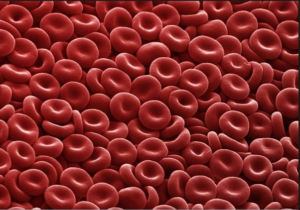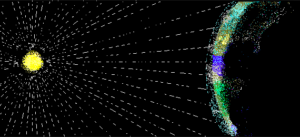Learning Objectives
- (2.2.1) – Write scientific notation
- (2.2.2) – Convert between scientific and decimal notation
- (2.2.3) – Multiply and divide numbers expressed in scientific notation
- (2.2.4) – Problem Solving With Scientific Notation
In the same way that exponents help us to be able to write repeated multiplication with little effort, they are also used to express large and small numbers without a lot of zeros and confusion. Scientists and engineers make use of exponents regularly to keep trace of the place value of numbers that they are working with to make calculations.
(2.2.1) – Write scientific notation
Before we can convert between scientific and decimal notation, we need to know the difference between the two. Scientific notation is used by scientists, mathematicians, and engineers when they are working with very large or very small numbers. Using exponential notation, large and small numbers can be written in a way that is easier to read.
When a number is written in scientific notation, the exponent tells you if the term is a large or a small number. A positive exponent indicates a large number and a negative exponent indicates a small number that is between 0 and 1. It is difficult to understand just how big a billion or a trillion is. Here is a way to help you think about it.
| Word | How many thousands | Number | Scientific Notation |
| million | 1000 x 1000 = a thousand thousands | 1,000,000 | [latex]10^6[/latex] |
| billion | (1000 x 1000) x 1000 = a thousand millions | 1,000,000,000 | [latex]10^9[/latex] |
| trillion | (1000 x 1000 x 1000) x 1000 = a thousand billions | 1,000,000,000,000 | [latex]10^{12}[/latex] |
1 billion can be written as 1,000,000,000 or represented as [latex]10^9[/latex]. How would 2 billion be represented? Since 2 billion is 2 times 1 billion, then 2 billion can be written as [latex]2\times10^9[/latex].
A light year is the number of miles light travels in one year, about 5,880,000,000,000. That’s a lot of zeros, and it is easy to lose count when trying to figure out the place value of the number. Using scientific notation, the distance is [latex]5.88\times10^{12}[/latex] miles. The exponent of 12 tells us how many places to count to the left of the decimal. Another example of how scientific notation can make numbers easier to read is the diameter of a hydrogen atom, which is about 0.00000005 mm, and in scientific notation is [latex]5\times10^{-8}[/latex] mm. In this case the [latex]-8[/latex] tells us how many places to count to the right of the decimal.
Outlined in the box below are some important conventions of scientific notation format.
Scientific Notation
A positive number is written in scientific notation if it is written as [latex]a\times10^{n}[/latex] where the coefficient a is [latex]1\leq{a}<10[/latex], and n is an integer.
Look at the numbers below. Which of the numbers is written in scientific notation?
| Number | Scientific Notation? | Explanation |
| [latex]1.85\times10^{-2}[/latex] | yes | [latex]1\leq1.85<10[/latex] [latex]-2[/latex] is an integer |
| [latex]\displaystyle 1.083\times {{10}^{\frac{1}{2}}}[/latex] | no | [latex]\displaystyle \frac{1}{2}[/latex] is not an integer |
| [latex]0.82\times10^{14}[/latex] | no | 0.82 is not [latex]\geq1[/latex] |
| [latex]10\times10^{3}[/latex] | no | 10 is not < 10 |
Now let’s compare some numbers expressed in both scientific notation and standard decimal notation in order to understand how to convert from one form to the other. Take a look at the tables below. Pay close attention to the exponent in the scientific notation and the position of the decimal point in the decimal notation.
0.05[latex]5\times10^{-2}[/latex] 0.0008[latex]8\times10^{-4}[/latex] 0.00000043[latex]4.3\times10^{-7}[/latex] 0.000000000625[latex]6.25\times10^{-10}[/latex]
|
Large Numbers |
Small Numbers |
|||
| Decimal Notation | Scientific Notation | Decimal Notation | Scientific Notation | |
| 500.0 | [latex]5\times10^{2}[/latex] | |||
| 80,000.0 | [latex]8\times10^{4}[/latex] | |||
| 43,000,000.0 | [latex]4.3\times10^{7}[/latex] | |||
| 62,500,000,000.0 | [latex]6.25\times10^{10}[/latex] | |||
Convert from decimal notation to scientific notation
To write a large number in scientific notation, move the decimal point to the left to obtain a number between 1 and 10. Since moving the decimal point changes the value, you have to multiply the decimal by a power of 10 so that the expression has the same value.
Let’s look at an example.
[latex]\begin{array}{r}180,000.=18,000.0\times10^{1}\\1,800.00\times10^{2}\\180.000\times10^{3}\\18.0000\times10^{4}\\1.80000\times10^{5}\\180,000=1.8\times10^{5}\end{array}[/latex]
Notice that the decimal point was moved 5 places to the left, and the exponent is 5.
Example
Write the following numbers in scientific notation.
- [latex]920,000,000[/latex]
- [latex]10,200,000[/latex]
- [latex]100,000,000,000[/latex]
To write a small number (between 0 and 1) in scientific notation, you move the decimal to the right and the exponent will have to be negative, as in the following example.
[latex]\begin{array}{r}\underset{\longrightarrow}{0.00004}=00.0004\times10^{-1}\\000.004\times10^{-2}\\0000.04\times10^{-3}\\00000.4\times10^{-4}\\000004.\times10^{-5}\\0.00004=4\times10^{-5}\end{array}[/latex]
You may notice that the decimal point was moved five places to the right until you got to the number 4, which is between 1 and 10. The exponent is [latex]−5[/latex].
Example
Write the following numbers in scientific notation.
- [latex]0.0000000000035[/latex]
- [latex]0.0000000102[/latex]
- [latex]0.00000000000000793[/latex]
In the following video you are provided with examples of how to convert both a large and a small number in decimal notation to scientific notation.
(2.2.2) – Convert from scientific notation to decimal notation
You can also write scientific notation as decimal notation. Recall the number of miles that light travels in a year is [latex]5.88\times10^{12}[/latex], and a hydrogen atom has a diameter of [latex]5\times10^{-8}[/latex] mm. To write each of these numbers in decimal notation, you move the decimal point the same number of places as the exponent. If the exponent is positive, move the decimal point to the right. If the exponent is negative, move the decimal point to the left.
[latex]\begin{array}{l}5.88\times10^{12}=\underset{\longrightarrow}{5.880000000000.}=5,880,000,000,000\\5\times10^{-8}=\underset{\longleftarrow}{0.00000005.}=0.00000005\end{array}[/latex]
For each power of 10, you move the decimal point one place. Be careful here and don’t get carried away with the zeros—the number of zeros after the decimal point will always be 1 less than the exponent because it takes one power of 10 to shift that first number to the left of the decimal.
Example
Write the following in decimal notation.
- [latex]4.8\times10{-4}[/latex]
- [latex]3.08\times10^{6}[/latex]
Think About It
To help you get a sense of the relationship between the sign of the exponent and the relative size of a number written in scientific notation, answer the following questions. You can use the textbox to write your ideas before you reveal the solution.
1. You are writing a number whose absolute value is greater than 1 in scientific notation. Will your exponent be positive or negative?
2.You are writing a number whose absolute value is between 0 and 1 in scientific notation. Will your exponent be positive or negative?
3. What power do you need to put on 10 to get a result of 1?
In the next video you will see how to convert a number written in scientific notation into decimal notation.
(2.2.3) – Multiply and Divide Numbers in Scientific Notation
Numbers that are written in scientific notation can be multiplied and divided rather simply by taking advantage of the properties of numbers and the rules of exponents that you may recall. To multiply numbers in scientific notation, first multiply the numbers that aren’t powers of 10 (the a in [latex]a\times10^{n}[/latex]). Then multiply the powers of ten by adding the exponents.
This will produce a new number times a different power of 10. All you have to do is check to make sure this new value is in scientific notation. If it isn’t, you convert it.
Let’s look at some examples.
Example
[latex]\left(3\times10^{8}\right)\left(6.8\times10^{-13}\right)[/latex]
Example
[latex]\left(8.2\times10^{6}\right)\left(1.5\times10^{-3}\right)\left(1.9\times10^{-7}\right)[/latex]
In the following video you will see an example of how to multiply tow numbers that are written in scientific notation.
In order to divide numbers in scientific notation, you once again apply the properties of numbers and the rules of exponents. You begin by dividing the numbers that aren’t powers of 10 (the a in [latex]a\times10^{n}[/latex]. Then you divide the powers of ten by subtracting the exponents.
This will produce a new number times a different power of 10. If it isn’t already in scientific notation, you convert it, and then you’re done.
Let’s look at some examples.
Example
[latex]\displaystyle \frac{2.829\times 1{{0}^{-9}}}{3.45\times 1{{0}^{-3}}}[/latex]
Example (Advanced)
[latex]\displaystyle \frac{\left(1.37\times10^{4}\right)\left(9.85\times10^{6}\right)}{5.0\times10^{12}}[/latex]
Notice that when you divide exponential terms, you subtract the exponent in the denominator from the exponent in the numerator. You will see another example of dividing numbers written in scientific notation in the following video.
(2.2.4) – Problem Solving With Scientific Notation

Water Molecule
Learning rules for exponents seems pointless without context, so let’s explore some examples of using scientific notation that involve real problems. First, let’s look at an example of how scientific notation can be used to describe real measurements.
Think About It
Match each length in the table with the appropriate number of meters described in scientific notation below. Write your ideas in the textboxes provided before you look at the solution.
| The height of a desk | Diameter of water molecule | Diameter of Sun at its equator |
| Distance from Earth to Neptune | Diameter of Earth at the Equator | Height of Mt. Everest (rounded) |
| Diameter of average human cell | Diameter of a large grain of sand | Distance a bullet travels in one second |
| Power of 10, units in meters | Length from table above |
| [latex]10^{12}[/latex] | |
| [latex]10^{9}[/latex] | |
| [latex]10^{6}[/latex] | |
| [latex]10^{4}[/latex] | |
| [latex]10^{2}[/latex] | |
| [latex]10^{0}[/latex] | |
| [latex]10^{-3}[/latex] | |
| [latex]10^{-5}[/latex] | |
| [latex]10^{-10}[/latex] |

Red Blood Cells
One of the most important parts of solving a “real” problem is translating the words into appropriate mathematical terms, and recognizing when a well known formula may help. Here’s an example that requires you to find the density of a cell, given its mass and volume. Cells aren’t visible to the naked eye, so their measurements, as described with scientific notation, involve negative exponents.
Example
Human cells come in a wide variety of shapes and sizes. The mass of an average human cell is about [latex]2\times10^{-11}[/latex] grams[1]Red blood cells are one of the smallest types of cells[2], clocking in at a volume of approximately [latex]10^{-6}\text{ meters }^3[/latex].[3] Biologists have recently discovered how to use the density of some types of cells to indicate the presence of disorders such as sickle cell anemia or leukemia. [4] Density is calculated as the ratio of [latex]\frac{\text{ mass }}{\text{ volume }}\\[/latex]. Calculate the density of an average human cell.
The following video provides an example of how to find the number of operations a computer can perform in a very short amount of time.

Light traveling from the sun to the earth.
In the next example, you will use another well known formula, [latex]d=r\cdot{t}[/latex], to find how long it takes light to travel from the sun to the earth. Unlike the previous example, the distance between the earth and the sun is massive, so the numbers you will work with have positive exponents.
Example
The speed of light is [latex]3\times10^{8}\frac{\text{ meters }}{\text{ second }}\\[/latex]. If the sun is [latex]1.5\times10^{11}[/latex] meters from earth, how many seconds does it take for sunlight to reach the earth? Write your answer in scientific notation.
In the following video you will see that the total number of miles run by the participants in the Boston marathon is larger than the circumference of the earth!
https://youtu.be/san2avgwu6k
Summary
Scientific notation was developed to assist mathematicians, scientists, and others when expressing and working with very large and very small numbers. Scientific notation follows a very specific format in which a number is expressed as the product of a number greater than or equal to one and less than ten, and a power of 10. The format is written [latex]a\times10^{n}[/latex], where [latex]1\leq{a}<10[/latex] and n is an integer. To multiply or divide numbers in scientific notation, you can use the commutative and associative properties to group the exponential terms together and apply the rules of exponents.
Candela Citations
- Revision and Adaptation. Provided by: Lumen Learning. License: CC BY: Attribution
- Unit 11: Exponents and Polynomials, from Developmental Math: An Open Program. Provided by: Monterey Institute of Technology and Education. Located at: http://nrocnetwork.org/dm-opentext. License: CC BY: Attribution
- Examples: Write a Number in Scientific Notation. Authored by: James Sousa (Mathispower4u.com) for Lumen Learning. Located at: https://youtu.be/fsNu3AdIgdk. License: CC BY: Attribution
- Examples: Writing a Number in Decimal Notation When Given in Scientific Notation. Authored by: James Sousa (Mathispower4u.com) for Lumen Learning. Located at: https://youtu.be/8BX0oKUMIjw. License: CC BY: Attribution
- Examples: Dividing Numbers Written in Scientific Notation. Authored by: James Sousa (Mathispower4u.com) . Located at: https://youtu.be/8BX0oKUMIjw. License: CC BY: Attribution
- Examples: Multiplying Numbers Written in Scientific Notation. Authored by: James Sousa (Mathispower4u.com) for Lumen Learning. Located at: https://youtu.be/5ZAY4OCkp7U. License: CC BY: Attribution
- Orders of magnitude (mass). (n.d.). Retrieved May 26, 2016, from https://en.wikipedia.org/wiki/Orders_of_magnitude_(mass) ↵
- How Big is a Human Cell? ↵
- How big is a human cell? - Weizmann Institute of Science. (n.d.). Retrieved May 26, 2016, from http://www.weizmann.ac.il/plants/Milo/images/humanCellSize120116Clean.pdf ↵
- Grover, W. H., Bryan, A. K., Diez-Silva, M., Suresh, S., Higgins, J. M., & Manalis, S. R. (2011). Measuring single-cell density. Proceedings of the National Academy of Sciences, 108(27), 10992-10996. doi:10.1073/pnas.1104651108 ↵